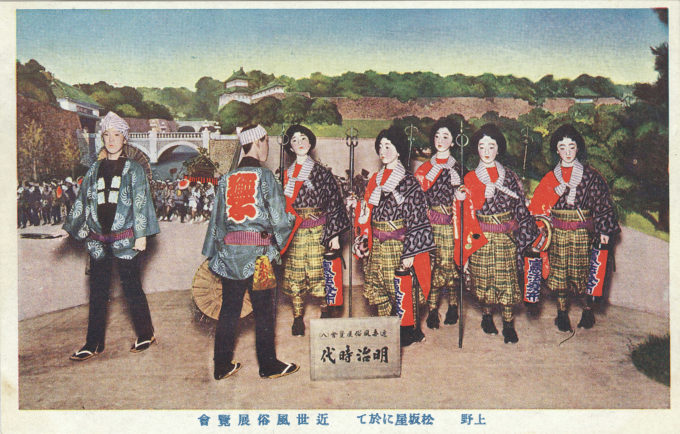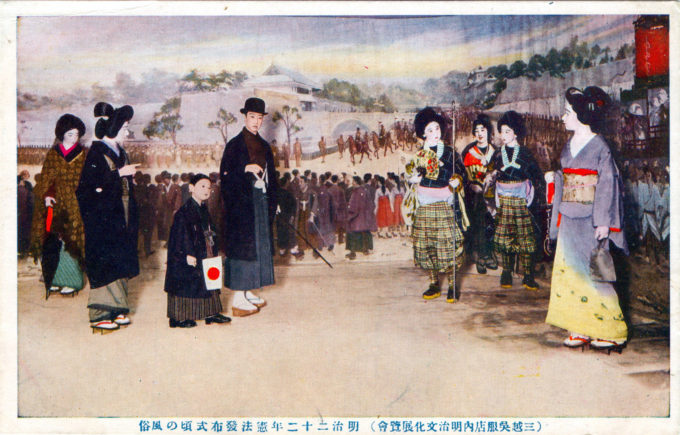
Onna-bugeisha mannequins on display at one of the “modern customs exhibition” window displays exhibited at Matsuzakaya department store, Ueno, c. 1920. During the Meiji era (1868-1912), a martial art for women, focused on the use of the naginata, was created. The legendary Empress Jingu (169-269), from whose exploits the onna-bugeisha were later derived, was the first woman to appear on a Japanese banknote – in 1888.
See also:
Imperial Palace panorama, c. 1920.
“[T]he ladies of Edo Castle [during the Tokugawa era] lived in seclusion. Visitors were admitted no further than the edge of the omote, the outer palace, where the bureaucrats dealt with affairs of state. Beyond that lay the naka-oku or middle palace, the residence of the shogun and his personal servants. On the far side of that was a solid wall slicing through the complex of buildings, pierced with a single opening. Only one man could pass through the door: the shogun.
“The o-oku, the ‘great interior’ or women’s palace, was larger than the omote and the naka-oku put together. So much mystery surrounds it that it is not even clear how many women lived there, though the most commonly accepted figure is three thousand.
“With no male guards, the women had to be responsible for protecting the shogun. There were units of women guards skilled with the naginata – the ‘long-handled spear’, akin to a halberd. Consisting of a long curved blade as sharp as a razor, fitted to the end of a staff considerably longer than a sword, it gave a woman the chance to get in a good swipe at a man’s legs before he could reach her.
“Most women of the warrior class were adept with the halberd, but the women of the inner palace were particularly formidable. They studied the art from childhood and prided themselves on their fearlessness and their skill at striking, thrusting, slashing, parrying and blocking. Every woman had a uniform – a thick black broadcloth jacket, stiff black pleated trousers and a black silk cap bound with a white band – and there was a training hall in the palace where they practised.
“In fact the shogun was never attacked in the women’s palace. Several shoguns were assassinated, but their enemies always found other ways to reach them. One was cut down in the outer palace and a couple were poisoned, probably by treacherous ladies-in-waiting. Perhaps the killers knew that if they tried to break into the women’s palace, they would be fought off.”
– Secret’s of the Shogun’s Harem, by Lesley Downer, 2008

In the background is a Mitsukoshi-Nihonbashi department store in-store diorama of the Imperial Palace, c. 1930, commemorating the 1889 (Meiji 22) promulgation of the Meiji Constitution. In the foreground, to the right, are store mannequins dressed as Onna-bugeisha – feudal-era castle guards – holding naginata. To the left are a mannequin “family” as they might be formally dressed circa 1889.

